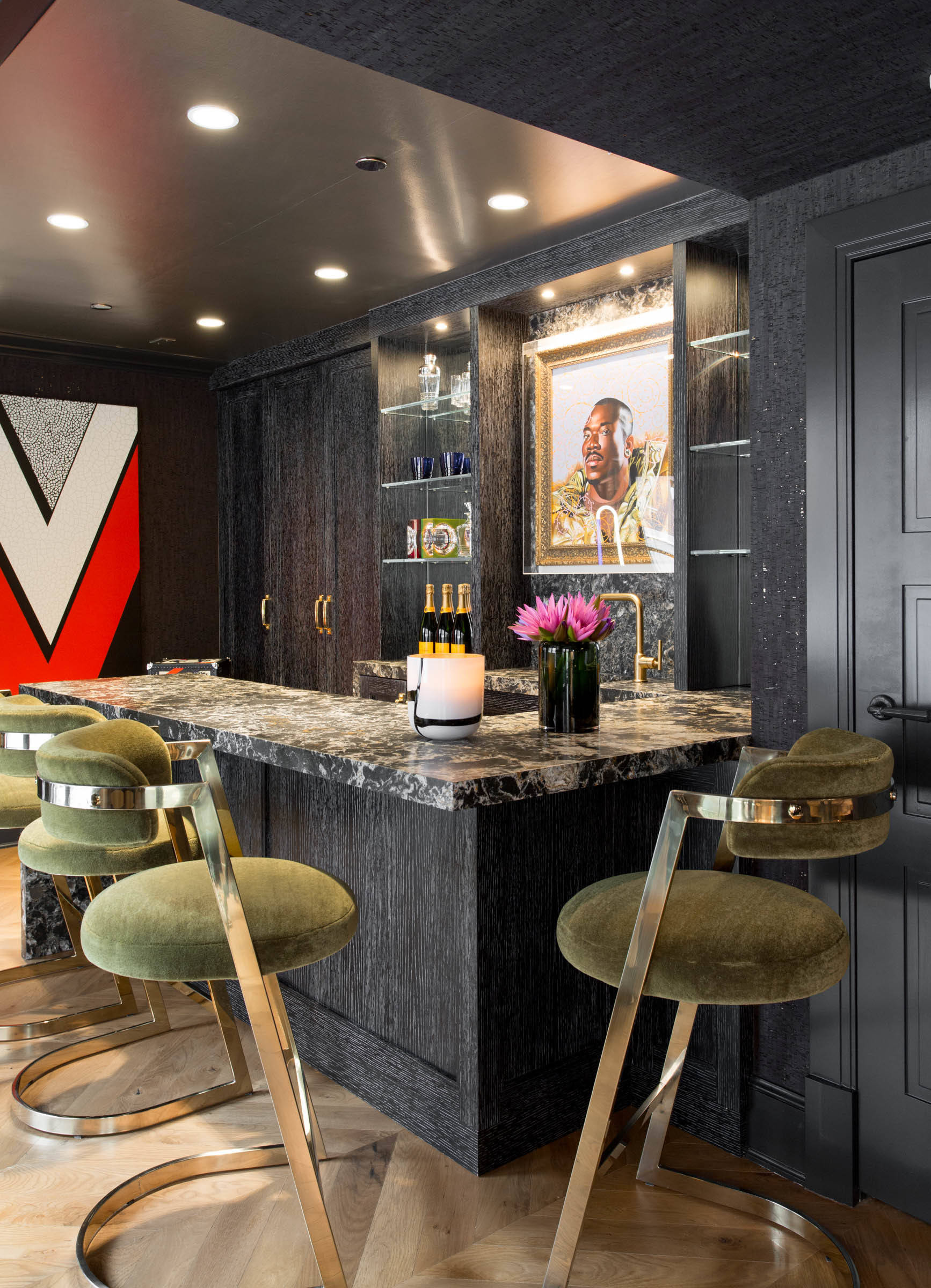Transform your dining room into the ultimate entertainment hub with a dedicated bar area. Whether you envision a sleek cocktail lounge or a cozy wine-tasting corner, this guide provides the inspiration and practical advice you need to design the dining room bar of your dreams.
Crafting Your Perfect Home Bar
Creating a dining room bar is about more than just storing drinks; it’s about crafting a space that reflects your style and enhances your dining experience. From casual wine nights to lively cocktail parties, your home bar can become the heart of your home’s social scene.
Choosing the Right Bar Type
The first step is determining the type of bar that best suits your lifestyle and needs. Here’s a breakdown of popular options:
-
The Wet Bar: The Mixologist’s Haven: Equipped with a sink and running water, a wet bar simplifies cocktail preparation and cleanup. It’s ideal for those who frequently entertain and enjoy crafting elaborate drinks. However, be prepared for the added complexity and cost of plumbing installation.
-
The Dry Bar: Stylish Simplicity: A dry bar prioritizes storage and display, showcasing your favorite beverages and glassware. This simpler, more budget-friendly option is perfect for wine enthusiasts and those who prefer a tidy, organized space.
-
The Bar Cart: Mobile Entertaining: Perfect for smaller spaces or those who value flexibility, a bar cart adds a touch of vintage charm and can be easily moved to wherever the party takes you.
-
The Built-in Bar: Seamless Integration: For a truly polished and permanent fixture, a built-in bar seamlessly integrates with your existing cabinetry, creating a cohesive and upscale aesthetic. Custom-built options offer the highest level of personalization but often come with a higher price tag.
-
The Freestanding Bar: A Statement Piece: Make a bold design statement with a freestanding bar. This versatile option works well in rental spaces or for those who enjoy rearranging their furniture.
Defining Your Bar’s Style
Now for the fun part – infusing your personality into your bar’s design! Here are some style inspirations:
-
Modern Minimalism: Clean lines, sleek materials (stainless steel, glass), and a neutral color palette create an understated yet elegant atmosphere.
-
Traditional Charm: Embrace timeless sophistication with rich woods, ornate details, and perhaps a touch of stained glass. Think dark mahogany and brass accents.
-
Rustic Retreat: Create a warm and inviting space with natural materials like reclaimed wood, stone, and wrought iron. This style celebrates imperfection and relaxed informality.
-
Transitional Blend: Merge classic and contemporary elements for a balanced and versatile look that incorporates both traditional and modern features.
-
Eclectic Mix: Express your unique style by blending different styles, colors, and textures. This style encourages creativity and individuality.
Space Planning and Functionality
Before finalizing your design, consider these practical aspects:
-
Space Assessment: Measure your available space carefully to determine the appropriate bar size and configuration.
-
Vertical Solutions: In smaller spaces, maximize vertical space with wall-mounted shelves or a floating bar. This preserves valuable floor space.
-
Integration vs. Standalone: Decide whether to integrate your bar into existing cabinetry or opt for a standalone piece. Consider your layout and desired aesthetic.
-
Storage: Ensure ample storage for glassware, liquor, mixers, and bar tools. Utilize drawers, cabinets, and open shelving for organized accessibility.
-
Seating: Provide comfortable bar stools or counter-height chairs that complement your bar’s height and dining room style.
-
Lighting: Install task lighting under cabinets for drink preparation and use pendant lights or sconces to create a warm and inviting ambiance.
-
Climate Control: For wet bars, a small refrigerator or ice maker keeps drinks perfectly chilled.
Material Selection
Choosing the right materials impacts both durability and style:
-
Wood: A classic choice offering warmth and character, available in various species and finishes.
-
Metal: Ideal for modern or industrial styles, metal is durable, easy to clean, and available in various finishes for different aesthetics.
-
Glass: Create a sense of openness and airiness, especially in smaller spaces. Glass allows light to pass through, enhancing brightness.
-
Stone: A luxurious and durable option, stone materials like granite, marble, or quartz create stunning focal points.
DIY vs. Professional Installation
-
DIY: A budget-friendly option for skilled individuals offering greater customization.
-
Professional: Recommended for complex projects involving plumbing to ensure proper installation and code compliance.
Budgeting
-
Wet Bar: Typically the most expensive due to plumbing and appliance installations.
-
Dry Bar/Bar Cart: More affordable alternatives.
-
Hidden Costs: Factor in materials, installation, and ongoing maintenance.
Creating your dream dining room bar is a personalized journey. Take your time, explore different ideas, and prioritize creating a space you’ll cherish for years to come. Are you looking for a way to make your dining room more stylish and inviting? Look no further than our dining room banquette and dining room table lights. With a wide variety of styles and finishes to choose from, you’re sure to find the perfect match for your home.
Dining Room Bar Integration: Tips and Ideas
Integrating a bar seamlessly into your dining room elevates your entertaining game and adds a touch of sophistication. Whether you have ample space or a cozy corner, a well-planned dining room bar can become a focal point for gatherings and everyday enjoyment.
Finding the Perfect Fit
-
Strategic Placement: Consider traffic flow and proximity to the dining and living areas. A bar tucked into a corner, against a wall, or even serving as a room divider can optimize space and encourage mingling. Designer Emily Henderson suggests placing the bar close to the dining area for convenient entertaining.
-
Cohesive Design: Maintain visual harmony by using similar colors, materials, and styles as your existing dining room décor. This creates a unified and intentional aesthetic.
-
Small Space Solutions:
- Mini-Bar Credenza: Transform a corner of your existing credenza or buffet into a compact and stylish mini-bar. Alvin Wayne suggests using a tray with decanters for an elegant touch.
- Hidden Bar: Maximize space in small dining rooms by concealing the bar behind closed cabinet doors when not in use. A stylish backsplash within the hidden bar area adds a surprising design element.
- Fold-Down Bar: Consider a fold-down bar unit that disappears completely when extra space is needed, providing maximum flexibility.
Exploring Bar Styles
-
Wet Bar: The Entertainer’s Choice: A wet bar with a sink and running water offers unparalleled convenience for preparing drinks and cleaning. Some experts suggest this is the ultimate for entertaining.
-
Dry Bar: Streamlined Elegance: A dry bar focuses on efficient storage and display for your beverages and glassware. It’s a simpler and often more budget-friendly choice that still enhances your dining experience.
-
Custom Built-in: Tailored Perfection: Integrate a custom-built bar seamlessly into your dining room’s architecture for a truly bespoke and polished look. This allows precise customization but can be more expensive.
-
Freestanding Bar: Versatile and Mobile: A freestanding bar unit or cart offers the ultimate flexibility. Move it around, rearrange your space, or even take it outdoors for patio parties. This is probably the easiest option for renters or those who like to change things up frequently.
Essential Bar Elements
-
Storage: Prioritize storage solutions like shelving, cabinets, drawers, and wine racks to keep your bar organized and functional.
-
Countertop: Select a durable and easy-to-clean countertop material like quartz or granite. Consider your style and how frequently the bar will be used.
-
Lighting: Enhance both functionality and ambiance with appropriate lighting. Under-cabinet lighting brightens your workspace, while pendant lights or a dimmer switch create a more relaxed atmosphere.
-
Seating: Provide comfortable bar stools or chairs that are the right height for your bar and complement your dining room’s style. Footrests add extra comfort.
Style and Décor
-
Complement Existing Decor: Harmonize your bar’s design with your dining room’s existing style. A sleek and minimalist bar complements a modern dining room, while a classic wooden bar suits a more traditional setting.
-
Personal Touches: Infuse your personality with artwork, decorative accessories, and unique barware. Display vintage cocktail shakers or a collection of quirky bottle openers to make it your own.
Planning for Success
| Feature | Considerations |
|---|---|
| Space | Maximize vertical space with shelving. Integrate the bar into existing furniture where possible. Consider hidden or fold-down options for smaller rooms. |
| Functionality | Ensure sufficient storage, comfortable seating, and adequate lighting. Consider how you will use the bar and incorporate features that support those activities. |
| Budget | Wet bars are generally more expensive. Freestanding bars and dry bars are usually more budget-friendly. Explore different materials to find options within your price range. |
| Style | Complement existing décor. Add personal touches. |
With careful planning and a dash of creativity, you can transform your dining room into a sophisticated and functional entertainment space. The best bar for your dining room depends on your individual needs, space, and style.
Decoding Dining Table Heights: A Comprehensive Guide
Choosing the right dining table height is crucial for creating a comfortable and functional dining space. While standard dining height is the most common, counter and bar height tables offer unique advantages for different lifestyles and spaces. Understanding these distinctions will help you make the perfect choice for your needs.
Dining, Counter, and Bar Heights: What’s the Difference?
Think of table height selection like Goldilocks and the Three Bears – it’s about finding the “just right” fit.
-
Dining Height (28-30 inches): The classic and most common height, offering comfort for extended meals. Pairs perfectly with standard dining chairs, promoting relaxed conversation and easy movement. This height is likely what comes to mind when picturing a traditional dining setting.
-
Counter Height (34-36 inches): Provides a more casual and informal dining experience, often seen in kitchens and eat-in areas. Counter height tables pair with counter stools and are suitable for quick meals, casual gatherings, or even working from home. While comfortable for some, others may find this height less suitable for long, formal meals.
-
Bar Height (40-42 inches): The tallest option, creating a lively and social atmosphere. Typically found in bars and restaurants, bar height tables encourage mingling and conversation. They pair with bar stools and can create the illusion of more space, which is beneficial in smaller homes. While visually appealing, bar height may not be ideal for extended, formal dining experiences.
| Table Height | Height from Floor | Typical Use | Seating | Feel |
|---|---|---|---|---|
| Dining | 28-30 inches | Formal and casual dining | Dining chairs | Comfortable, traditional |
| Counter | 34-36 inches | Casual dining, kitchens | Counter stools | Relaxed, informal |
| Bar | 40-42 inches | Social gatherings, bars | Bar stools | Lively, energetic |
Counter vs. Bar Height: A Closer Look
| Feature | Counter Height (36″) | Bar Height (40-42″) |
|---|---|---|
| Atmosphere | Casual, bistro-like | Lively, social |
| Common Use | Kitchen islands, eat-in kitchens | Bars, restaurants, entertainment areas |
| Stool Height | 24-26 inches | 28-33 inches |
| Family-Friendly | Generally more accessible for children | Can be challenging for young children |
| Functionality | Can accommodate some kitchen tasks | Primarily for seating and socializing |
Choosing the Right Height for Your Needs
Several factors influence your ideal table height:
-
Space: Bar height tables can make smaller rooms feel more open. Larger rooms can comfortably accommodate standard height tables.
-
Lifestyle: Consider how you typically use your dining area. Do you prefer casual family meals, formal entertaining, or a multi-purpose space?
-
Accessibility: Standard height is generally the most accessible option for children and individuals with mobility limitations.
-
Aesthetics: Each height contributes to a different aesthetic – traditional, modern, or trendy.
Emerging trends suggest blurring the lines between these categories with “gathering tables” or adjustable height tables offering greater flexibility. While these categories provide a framework, don’t be afraid to think outside the box and explore creative options. Current research on dining table ergonomics and design trends is constantly evolving, so continue exploring to find what works best for you.
Small Dining Room, Big Style: Creative Solutions for Compact Spaces
Having a smaller dining area doesn’t mean sacrificing style or functionality. These cozy spaces can be incredibly charming and inviting with the right design approach. Whether you call it a dinette, nook, breakfast nook, or simply a small dining room, there are numerous ways to maximize its potential.
Defining Small Dining Areas
The terminology for small dining areas can be somewhat fluid, but here’s a general guideline:
-
Dinette: A compact dining area, often adjacent to or within the kitchen, typically furnished with a table and chairs. It’s a practical space for everyday meals. While sometimes used interchangeably with “breakfast nook,” a dinette might suggest a slightly more formal eating area.
-
Nook: A cozy and defined space, often tucked into a corner or alcove, specifically designed for dining. Nooks frequently feature built-in seating like benches, maximizing space and creating an intimate feel.
-
Breakfast Nook: A smaller, informal dining area typically used for breakfast but adaptable for other meals. It’s often located near the kitchen and may feature built-in seating.
| Term | Description | Likely Features |
|---|---|---|
| Dinette | Compact dining area, often in or near the kitchen, for casual meals. | Table and chairs |
| Nook | Cozy corner or alcove designed for dining. | Built-in seating (e.g., benches) |
| Breakfast Nook | Small, informal dining area typically used for breakfast but can also host other meals. | Often features built-in seating, near kitchen |
Maximizing Your Small Dining Space
Here’s how to make the most of your compact dining area:
-
Built-ins: Built-in benches or banquette seating save space and offer valuable storage underneath.
-
Furniture Selection: Choose smaller-scale tables and chairs. A drop-leaf table offers flexibility for expanding when needed. Some experts believe round tables improve flow in small spaces, while others favor rectangular tables. Ultimately, the best choice depends on your room’s shape and personal preference.
-
Vertical Space: Install shelves or floating cabinets above the dining area for storing tableware and other essentials. This keeps surfaces clear and maximizes every inch.
-
Strategic Décor: Mirrors can create the illusion of more space. Well-placed lighting enhances ambiance and makes the area feel larger and more inviting. Studies suggest brighter spaces appear larger, so consider adding more light fixtures or using lighter paint colors.
Design Inspiration
-
Modern Minimalist: Clean lines, neutral colors, and sleek furniture create a contemporary and spacious feel.
-
Cozy Cottage: Warm colors, natural textures, and comfortable seating transform your nook into a charming and inviting space.
-
Industrial Chic: Exposed brick, metal accents, and vintage-inspired furniture add a touch of edginess and personality.
-
Scandinavian Simplicity: Functionality, natural light, and a neutral color palette create a bright, airy space.
No matter what you call it, embrace the coziness and create a small dining area you love. Personalize the space to reflect your unique style and ensure it functions perfectly for your needs. Ongoing research in small space design offers continuously evolving ideas, so keep exploring to discover what works best for you. Are you looking for a way to make your dining room more stylish and inviting? Look no further than our dining room banquette and dining room table lights. With a wide variety of styles and finishes to choose from, you’re sure to find the perfect match for your home.
- Greenhouse Storage Shed Combos: Your Guide to Combining Growing and Storage - April 21, 2025
- Greenhouse Shed Combo: Design, Build & Grow Year-Round - April 21, 2025
- Gingham vs. Plaid: What’s the Difference? A Complete Guide - April 21, 2025










